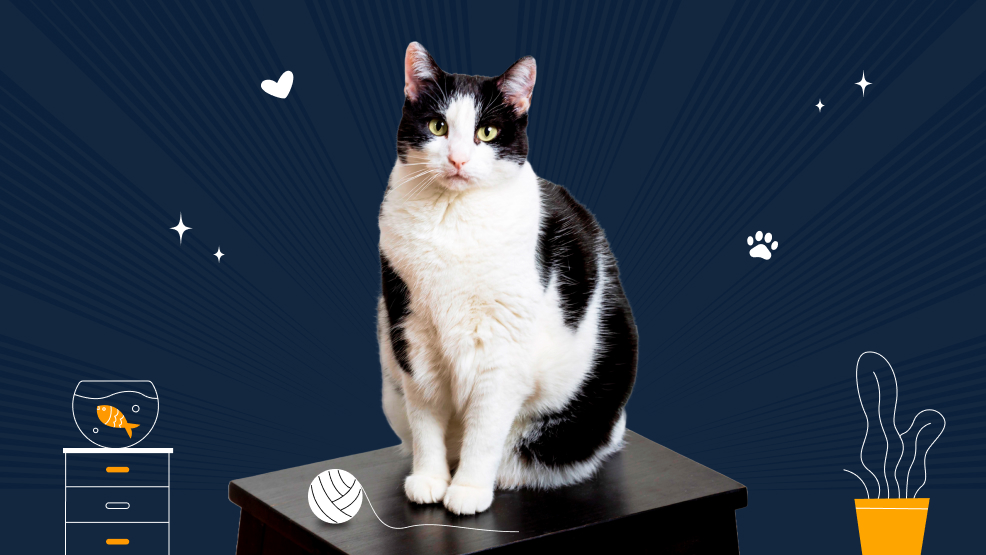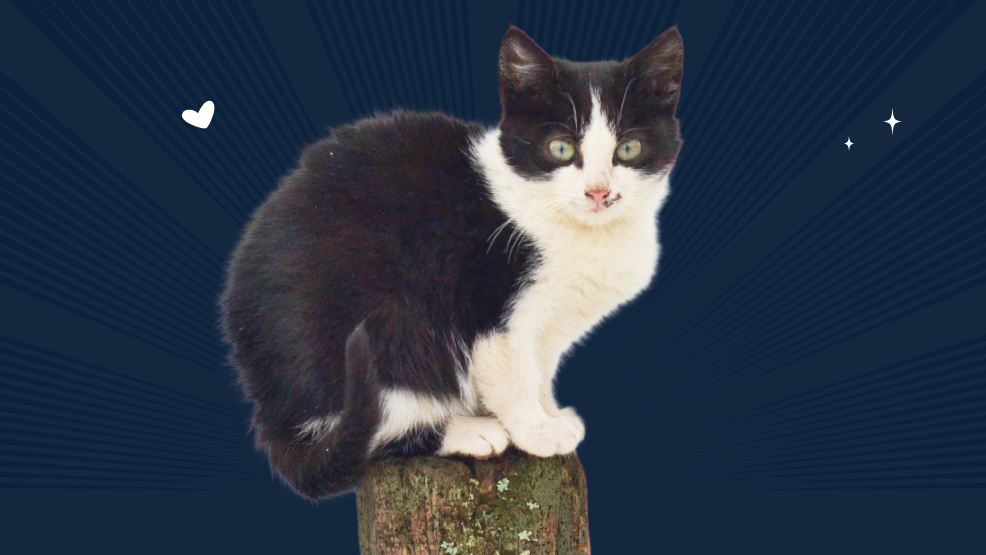The Lowdown on Tuxedo Cats: What Kind of Cat is a Tuxedo Cat?


When I was around 10-11 years old, I had a cat with a fascinating black and white coat pattern. I was very fond of the cat and often played with it. But one day, it escaped and never came back. I kept hoping it would come back, but when I realized the cat wouldn’t actually come back, I was miserable for at least several weeks.
So, when, a few days back, I came across a stray kitten with a black and white coat pattern exactly like my childhood cat, I immediately took it home with me. Since I had no idea how to care for a cat, I googled black and white cat and came across the term “tuxedo cat.”
You can imagine my surprise when I learned that the “tuxedo cat” is not a separate cat breed but a coat pattern. I was so intrigued that I immediately sat down to do a lot of research and asked my vet many many questions. Here’s what I found out.
What Kind of Cat is a Tuxedo Cat?

As mentioned in the section above, the “tuxedo cat” is not a separate breed. It is a term used to describe a unique bicolor coat pattern in cats. So, if you are wondering what makes a cat a tuxedo cat, the answer is that these cats sport sleek black coats adorned with white markings on their paws, chest, belly, and sometimes their face.
Because of this, it looks like they are wearing a white shirt underneath a black dinner jacket, thus creating a striking resemblance to a formal tuxedo suit. Now that you know what does a tuxedo cat look like, it’s important to note that the term “tuxedo cat” is not a breed but a descriptive term for this particular coat pattern.
What Causes the Tuxedo Coat Pattern in Cats?

The tuxedo coat pattern in cats is primarily caused by the white spotting gene, also known as the piebald gene. This gene affects the distribution of pigment cells, leading to the distinctive black-and-white pattern that resembles a tuxedo.
The white spotting gene prevents pigment-producing cells (melanocytes) from migrating to certain areas of the cat’s body during development. This results in patches of white fur on a predominantly black background. The degree of white spotting is often categorized into grades. Lower grades (1-4) have less white, while higher grades (5-10) have more extensive white areas.
Another thing you need to know is that the extent and location of the white patches can vary widely. Some tuxedo cats have minimal white, while others have more extensive white areas. This variation is due to how the gene is expressed.
Moreover, the white spotting gene interacts with other color genes to create the tuxedo pattern. For example, a cat with the genes for black fur and the white spotting gene will display the classic black-and-white tuxedo look.
The tuxedo pattern can appear in many different breeds and mixed-breed cats. Read on to find out about popular cat breeds.
Popular Types of Tuxedo Cats
Since “tuxedo cat” refers to a coat pattern rather than a specific breed, several recognized cat breeds can exhibit this particular coat coloration. Some popular black and white tuxedo cat breeds include:
British Shorthair

The British Shorthair cat is a medium to large size cat known for its distinctive appearance – they have a round face with chubby cheeks, large round eyes (often gold or copper colored), and small but widely spaced ears.
The most recognizable feature of this cat breed is its “British blue” coat color, but they also come in other colors and patterns. These are tabby, calico, bicolor, and tuxedo. The British Shorthair’s coat type is short, dense, and plush.
One of the most important things you need to know about this breed is that the British Shorthairs are not typically lap cats but enjoy being close to their human companions. They have an affectionate, easygoing, and calm temperament and are known for being friendly but not overly demanding attention. Along with British shorthair tuxedo cats, American shorthair, exotic shorthair, and oriental shorthair, they also sport tuxedo coats.
Maine Coon

The breed originated in the U.S. state of Maine and is one of the oldest natural breeds in North America. They were likely brought to America by early settlers and adapted to the harsh New England climate. Maine Coons were designated the state cat of Maine in 1985.
Maine Coons are not just the oldest natural cat breeds. They are also one of the largest domesticated cat breeds. Males typically weigh between 13-18 pounds, but some can exceed 20 pounds. Females are slightly smaller.
Temperament-wise, Maine Coons are gentle giants. They are friendly, affectionate, and sociable and are often described as dog-like due to their playful and loyal nature.
Moreover, Maine Coons are quite intelligent and can be trained to perform tricks. A very interesting thing about Maine Coons is that they are known for their love of water and may enjoy playing in it.
However, Maine Coons have a long, shaggy, and water-resistant coat with a thick undercoat. Their fur is longer on the stomach and rear, and they have a bushy tail. Hence, they should be groomed twice a week to prevent matting.
Norwegian Forest Cat

The Norwegian Forest Cat, also known as the “Wegie” or “Skogkatt,” is an ancient breed with a rich history dating back to the time of the Vikings. They are believed to have been brought to Norway by early settlers and adapted to the harsh Scandinavian climate.
As a result, they have a thick double coat with a long, glossy top layer and a woolly undercoat for insulation against cold weather. Their coat can come in almost any color or pattern, such as tabby, solid, bicolor, tortoiseshell, calico, cameo, and smoke.
Their almond-shaped eyes are their most recognizable feature. It can be green, gold, green-gold, copper, and sometimes blue (mainly in white or partially white cats). Norwegian Forest Cats are friendly, affectionate, and playful.
They are known for being independent but still enjoy the company of their human families. However, they prefer to be near their humans rather than on their laps.
Persian Cat

The Persian cat has a long history, with origins tracing back to Persia (modern-day Iran). They were introduced to Europe in the 1600s and quickly became popular among the aristocracy owing to their adorable appearance and person
They have a round face with a flat, short muzzle, large, round eyes, and small, rounded ears. Their eyes can be copper, blue, green, or odd-eyed (one blue and one copper/green). Size-wise, they are medium to large cats and have sturdy, well-balanced bodies.
They typically weigh between 7-12 pounds. The coats of Persian cats are quite attractive – their coats are long, thick, and flowing and come in various colors and patterns. This includes solid, tabby, bicolor, and more.
Persians are known for their calm, gentle, and affectionate nature. They enjoy a quiet environment and are typically very loving towards their human companions. These cats love being lap cats and enjoy lounging around the house.
Siberian Cat

Just like the Norwegian Forest cat and the Persian cat, the Siberian is also an ancient feline breed originating in Siberia. They are native forest cats from Russia and well-adapted to the harsh climate.
Siberian cats have a sweet expression with a modified wedge-shaped head, large, almost round eyes, and tufted ears and paws. Their coat is triple-layered, water-resistant, and varies from coarse to soft. However, their thick coat requires regular grooming to prevent matting.
They are good with children and other pets, making them excellent family companions. These cats are intelligent and playful and love to climb and leap. So, make sure to provide a lot of interactive toys and cat trees. Siberians are also known for their love of water and enjoy playing in it.
So, if you are wondering, ‘what breed is my tuxedo cat’, consult a veterinarian or a reputable cat breeder for guidance. They may be able to identify your cat’s breed based on physical characteristics, temperament, and genetic testing.
Interesting Facts About Tuxedo Cats

Tuxedo cats are often referred to by various nicknames, such as “tuxies,” “formal cats,” or “black-and-white cats.”
- Many famous felines throughout history have been tuxedo cats, including Socks (the Clinton family’s cat), Snowbell (from the “Stuart Little” movies), and Sylvester (the iconic Looney Tunes character).
- In some cultures, tuxedo cats are believed to bring good luck and prosperity, particularly in professions related to the sea or water.
- Tuxedo cats can have varying degrees of white markings, ranging from a small white bib to extensive white patches covering a significant portion of their bodies.
- While most tuxedo cats have black and white coats, rare instances of tuxedo cats with different color combinations, such as blue and white or red and white, have been documented.
Tuxedo cats are more than just dashing fashion icons of the feline world; they are beloved companions with unique personalities and a rich history. Whether you’re captivated by their striking appearance or charmed by their playful antics, these cats are sure to steal your heart.
Remember, while the tuxedo coat pattern is a defining characteristic, each tuxedo cat is an individual with its quirks and traits. Embrace their individuality, provide them with a loving home, and you’ll be rewarded with a lifetime of loyalty and affection from your dapper feline friend.
If you’re considering adding a tuxedo cat to your family, we encourage you to explore adoption options at your local animal shelters or rescue organizations. By giving them a forever home, you’ll be saving a life and gaining a devoted companion.









Leave A Comment